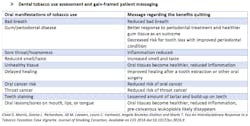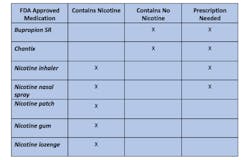Editor's Note: The author provides a long list of online resources for dental offices interested in tobacco cessation programs. We encourage the reader to scroll down to the bottom of this article.
By Jill Loewen, CDA, RDA, MS
Every dental patient should be asked about tobacco use (all kinds, in any amount) at every patient visit. There is nothing a person can do that can improve their health more than stopping tobacco use.
Tobacco dependence is considered a chronic and relapsing disease. Current research suggests that a person might try up to 20 attempts at quitting before becoming successful for the long term. These attempts at quitting provide us with valuable information we can use in planning the next attempt, as long as we learn what worked and what didn’t from the previous attempts. It’s more about “skillpower” than “willpower.”
When you ask a patient about their use of tobacco, be sure to ask specifically about use of any amount of tobacco in any form. Specifically state that you’re asking about not only cigarettes, but cigars, pipes, smokeless, hookah, electronic cigarettes and vaporizers, and any other type. Social smokers don’t often consider themselves smokers so may not identify themselves unless we ask for specifics. If someone uses a nontraditional form of tobacco such as hookah, they may not consider themselves a smoker because of how it is used.
If a patient is not interested in quitting when you’ve tried to motivate and encourage them, the progress note needs to reflect this: “Patient was advised about the health consequences of tobacco use and the benefits of quitting. Patient declined treatment at this time.” Do not give up! Work toward getting to know that patient and what might be motivating for the person. Studies have shown that planting a seed can likely lead to success down the road. Sometimes just your concern and discussion with a patient can lead someone to quit.
Our patients must know that we are obligated to not only ask them about their tobacco use, but to discuss it. Their tobacco use impacts their oral health. Be sure to inform them about how tobacco affects their oral health. A good time for this discussion is during the intraoral and extraoral examination. Explain what you look for during an exam and the high risk of oral cancer and other oral health consequences from tobacco use. Patients should be informed that the first signs of tobacco use usually appear in the mouth. Have literature about tobacco use in the patient reception area for patients to read and take home.
Successfully becoming tobacco free is possible for anyone. First and foremost, they must have the desire to quit. If that doesn’t exist, quitting will never happen. It requires behavior changes related to tobacco use “triggers” and the identification of “barriers.” This represents a lifestyle change for most people and helps explain why it is so difficult, but it is doable.
Patients should be told about the many options for treatment. Web-based, toll free quit lines, group counseling, individual counseling, and cold turkey (self-directed quitting attempt with no medication) approaches can be used or possibly be combined. Careful planning (counseling and treatment) plus the use of an FDA-approved medication leads to the highest chance for success. Cold turkey attempts are the hardest, with 3% to 5% success rates. This doesn’t mean it can’t be done, just that it’s the hardest approach.
Detailed information about the chart above is available from the Centers for Disease Control and Prevention here.
You can offer tobacco dependence treatment to your patients in the practice setting. This treatment is a good fit for dental practices because of how it affects oral health, and because we develop trusting relationships with our patients. Imagine having the opportunity to provide such a lifesaving service! You will find patients are generally very appreciative, and helping patients is extremely rewarding.
Stress the benefits of quitting. Quitting at any age has benefits. Even after many years of tobacco use, good healing can result, and at a minimum, will lead to a better quality of life and add years to one’s life. Let’s all work together to help our patients stop using tobacco!
This is a great video. You can download and use it during the process of motivating your patients!
Tips for treatment of tobacco use dependence
Assist: Help patients with a plan to quit
- Gather comprehensive tobacco use history
- Discuss medical/dental effects of tobacco
- Discuss barriers to success and ways to overcome them
- Discuss benefits of quitting
- Identify patient triggers to tobacco use and ways to overcome them
- Develop a personalized plan to quit and identify coping strategies
- Discuss FDA-approved pharmacotherapy/nicotine replacement
- Patient should set a quit date within the next 30 days
- Provide patient with take home materials, quitting booklet, tip sheets, and resources packet
Arrange: Provide follow-up support for continued guidance and encouragement
- Contact patient within one week before the quit date
- Contact patient within one week after the quit date
- Contact patient between 25 and 35 days after the quit date
Source: Mackie ZF,Loewen JM, Savaya MG. Evaluation of a comprehensive tobacco dependence treatment program: dental students’ perceptions of preparedness and clinical practice. J Dent Educ 2015:79(8):949-958.
Tobacco use treatment resources for dental professionals
- Association for the Treatment of Tobacco Use and Dependence For acccredited training programs list, click here.
- Center for Tobacco Research and Intervention University of Wisconsin For dental specific information, click here or here.
To view a toolkit, Treating Tobacco Use for Dental Office Teams, click here.
- Clinician and patient materials
(http://www.ahrq.gov/professionals/clinicians-providers/guidelines-recommendations/tobacco/index.html
Clinical Practice Guideline for Treatment of Tobacco Dependence (See Quick Reference Guide version that summarizes the information)
http://www.surgeongeneral.gov/initiatives/tobacco/index.html
- Dental professionals: Help your patients quit smoking
http://www.cdc.gov/tobacco/campaign/tips/partners/health/dental/
Fact sheet about Tips [PDF - 448KB]
FAQs for Health Care Providers
FAQs about how quitlines work and their effectiveness
A printable, pocket-sized tobacco intervention card [PDF - 80KB]
http://www.medscape.com/viewarticle/776542
Tips From Former Smokers Download Center
ADA-certified online dental course
"Talk With Your Dental Team" posters
Videos, print ads, and other Tips campaign materials from the Tips Download Center
- Explain how smoking is linked to gum disease and tooth loss.
- Suggest that your patients visit the I'm Ready to Quit! page
- Let your patients know they can get free quitting help by calling 1-800-QUIT-NOW (1-800-784-8669) or 1-855-DÉJELO-YA (1-855-335-3569).
- FDA: The Real Cost Campaign
- Manhattan Tobacco Cessation Program (dental toolkit)
- Tobacco Free! Curriculum Tobacco Dependence Training for Oral Health Educators and Clinicians
- University of Minnesota Tobacco Use Cessation Program (Division of Periodontology). For an office self-help manual, click here or here.









